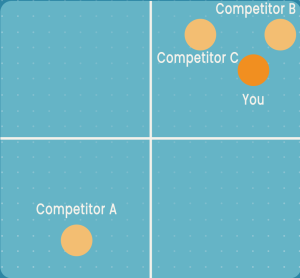I’ve searched far and wide for a magical button that will place my content squarely on top of my audiences’ timelines and say “Hey, don’t look over there! Look at me!” Sigh. If only it were that easy.
Finding a target audience is one thing. Getting that audience to see and engage with my content is another. That’s where positioning comes in. By using the third portion of the STP model, you can unlock strategies that will help set yourself apart from your competitors in the eyes of your viewers. Pair the STP model with social listening, and you’ll be unstoppable.
Think back to your last trip to the store. Is there a specific brand you buy? Or, do you look for the healthiest option? Or, do you have a food allergy that limits what you can purchase? These are some of the questions that brands will use to position themselves in front of an audience. Notice how this differs from the first two portions of the STP model: Segmenting and Targeting. Instead of researching demographic, geographic, and/or psychographic niches (which they should have already completed), brands are looking at ways they stand alone against competitors. In other words, segmentation breaks down what products different audiences look for, while positioning locates what brands audiences are drawn towards.
So, how do I set myself apart? Positioning maps.
Positioning maps are one of the greatest tools for finding my niche. Not only do they graphically represent my product alongside my competitors, but they also narrow down different factors in order to find the dominant traits. The more maps I can make, the better and more focused my positioning becomes.
Take one factor and rate it on a scale of 0 through 5. Let’s say my product is ground coffee and my factor is the caffeine amount per cup. Now, take another factor and rate it as well. Let’s say that factor is the price. Finally, follow the same procedures for various competitors. When charted, it may look something like this:
| Caffeine Amount (0 = Lowest Caffeine, 5 = Highest Caffeine) | Price (0 = Low price, 5 = High Price) | |
| My Brand | 4 | 3 |
| Competitor A | 2 | 1 |
| Competitor B | 5 | 4 |
| Competitor C | 3 | 4 |
Next, take those two factors and use them as axes for a graph, such as this:
These graphs visually represent where I stand among other brands. This graph tells me I am not so different from many of my competitors. My product has a relatively high level of caffeine for an above-average cost. Could a switch to a different quadrant give me some breathing room from my competitors? Maybe I can bring down caffeine levels and this new marketing campaign with studies that support less caffeine intake. I could be the first to have “heart-conscious, quality coffee” on the market.
But is being contrarian for its own sake always a good thing? What is typically the biggest reason for drinking coffee? Energy. So, it may not be a good idea to change caffeine content just because I’m afraid of being crowded next to my competitors. Maybe caffeine content is an essential, immutable factor for a marketable coffee. It may be time to look at different factors, like the variety of flavors, how environmentally friendly the production is, or something else. When you are making your own positioning maps, don’t be afraid to make five maps, ten maps, twenty maps, or even more. With each analysis, you will be led closer to the winning position.
To recap, positioning is the way we bring our products to our desired audience. There is plenty to cover on how we narrow down our audience, and plenty more on how to showcase our strong online brand.

Ben joined the NISM team as a Social Media Strategist in June of 2024. He graduated from Northern Kentucky University with a Bachelor of Arts in Electronic Media & Broadcasting in 2022 and with a Master of Business Administration in 2023. Ben enjoys making content as a Social Media Associate for the Kenton County Public Library. In his free time, he enjoys playing live music in the Cincinnati area, writing music with his band, and spending time with his amazing girlfriend either reading or watching TV (usually Vampire Diaries).



0 Comments